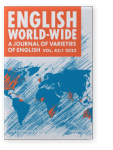Vol. 43:1 (2022) ► pp.1–32
Into-causatives in World Englishes
The paper analyses the frequency and use of the relatively rare, yet highly productive into-causative construction in twenty varieties of English on the basis of the 1.9-billion word Corpus of Web-based Global English (GloWbE; Davies 2013) [1] 1 and Schneider’s (2007) Dynamic Model. It hypothesises differences in frequency, variation in the preference for particularly frequent fillers as well as productivity differences in line with Schneider’s stages of linguistic evolution. However, it shows that only frequency differences reflect the Dynamic Model; with regard to the preference for frequent realisations and productivity, postcolonial varieties turn out to be very similar to British English. These results come as a surprise against the background of similar studies of the way-construction, where all of these effects have been documented convincingly. It is argued that the properties of into-causatives themselves (e.g. their idiomatic and semantic simplicity) might contribute to their more native-like usage patterns in postcolonial varieties of English.
Article outline
- 1.Introduction
- 2.Background
- 2.1The dynamic model of the evolution of New Englishes
- 2.2Construction grammar
- 2.2.1 Into-causatives from a construction grammar perspective
- 2.2.2Dimensions of constructional variation in World Englishes
- 2.2.2.1Frequency of non-compositional constructions in New Englishes
- 2.2.2.2Preference for frequent fillers
- 2.2.2.3Productivity of constructions in World Englishes
- 2.3Hypotheses
- 3.Methods and data
- 3.1Corpus and data extraction
- 3.2Annotation
- 3.3Statistical methods
- 3.3.1Correspondence analysis
- 3.3.2HCFA tests
- 3.3.3LRNE models
- 4.Results
- 4.1The frequency of into-causatives (hypothesis I)
- 4.2Filler preferences (hypothesis II)
- 4.2.1Broad overview of associations: Correspondence analysis
- 4.2.2Fillers of the cause slot
- 4.2.2.1Verbal lemmas in the cause slot
- 4.2.2.2Semantic classes in the cause slot
- 4.2.3Semantic classes of the fillers in the result slot
- 4.2.4Correlations between the fillers of the cause slot and the result slot
- 4.3Productivity (hypothesis III)
- 4.3.1Productivity of the cause slot
- 4.3.2Productivity of the result slot
- 5.Discussion
- 6.Conclusion
- Notes
-
References
